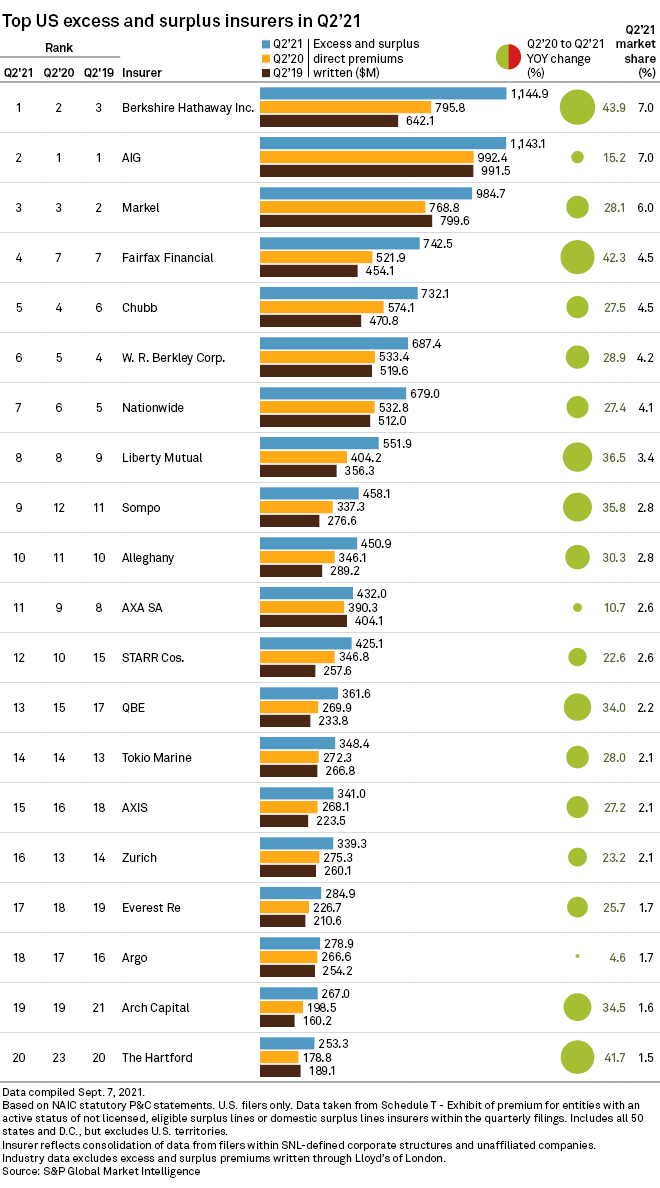Berkshire Hathaway Inc. and American International Group Inc. controlled very similar shares of the U.S. excess and surplus market during the second quarter of 2021, a period that saw growth of the segment overall continue strongly.
Berkshire Hathaway finished slightly ahead at $1.15 billion in direct written premiums, compared with AIG's $1.14 billion, an S&P Global Market Intelligence analysis of National Association of Insurance Commissioners statutory filings shows.
The tussle for the top spot came as the E&S market saw premiums rise sharply year over year. Direct written E&S premiums, excluding Lloyd's of London, rose 33.4% to $16.37 billion from $12.28 billion in the same quarter of 2020. That followed a 25.4% year-over-year increase in the first quarter and an 18.2% year-over-year increase for the full year of 2020.
Of the top 20 E&S writers, all but Argo Group International Holdings Ltd. produced double-digit year-over-year growth in the second quarter.

Pushing the accelerator
Fitch Ratings observed "accelerating growth" in the E&S market in the first half of 2021, according to Doug Pawlowski, a senior director in Fitch's North American insurance group. The lifting of pandemic restrictions bolstering the economy likely aided that growth, Pawlowski said in an interview. Persistently low interest rates have led to more underwriting discipline, pushing more business from the admitted market towards E&S writers, Pawlowski added.
The E&S segment traditionally grows in hardening markets, as admitted insurers become more selective about the risks they write and the capacity they commit to certain areas. Insurers have suffered increasing claims as catastrophes increase in frequency and severity and claimants and lawyers "become more creative with their claims," said Bruce Ballentine, senior credit officer at Moody's.
Pawlowski said E&S growth was particularly strong in business lines that have been challenging for admitted carriers, such as cyber and public company directors' and officers' liability. As well as getting more business, E&S writers are also seeing better prices. Pawlowski noted that both exposure and prices were "growing significantly and robustly."
Price increases are slowing in the P&C market more generally. Broker Marsh's quarterly global insurance index shows that price increases across all U.S. commercial lines weakened to 12% in the second quarter from 14% in the first quarter and 17% in the fourth quarter of 2020. Pawlowski expects E&S premiums to continue to grow robustly for the next couple of years, but "it's hard to say beyond that."
Ballentine said E&S growth has been faster than that in the overall property and casualty market "for some time." While there will continue to be an ebb and flow between the admitted and E&S markets as markets harden or soften, the longer-term trend points to better growth in the E&S space.
Improving results
There are also prospects for a return to underwriting profitability for the E&S market after a tough 2020. Fitch in an Aug. 31 report said the E&S market "materially underperformed" the broader P&C industry with a direct combined ratio, which excludes the effect of reinsurance, of 107%.
Pawlowski said Fitch sees something near breakeven for 2021, and the market could even do better than breakeven in 2022.
"They are getting good pricing," he said. "The environment is conducive to them having better underwriting results."
The risk of claims growth exceeding price increases remains, however. Moody's Ballentine said that although prices in the standard and E&S markets overall are rising faster than loss costs and there should be some improvement in underwriting margins, loss costs may accelerate "at any time" given the "creeping inflation risk."



